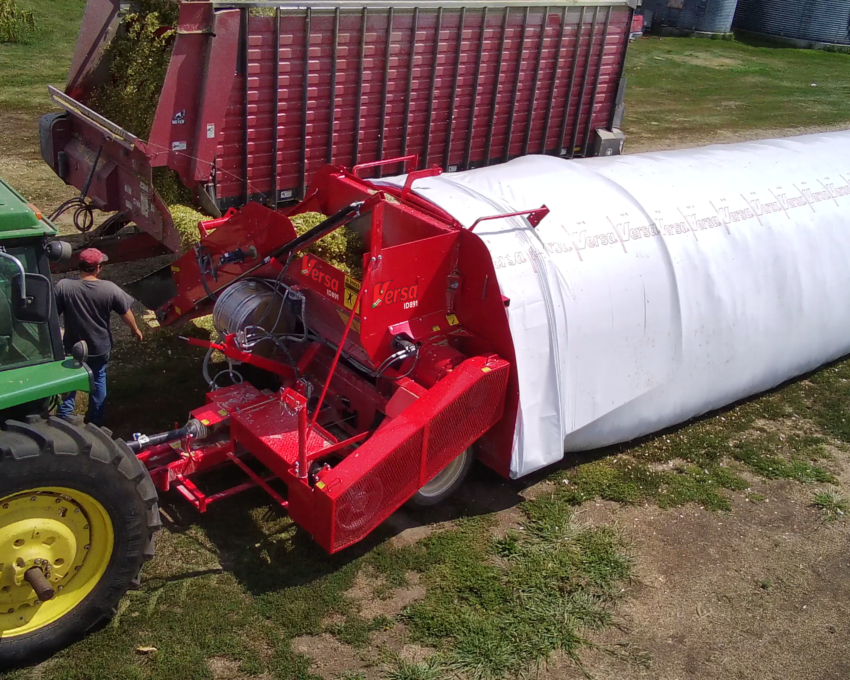Dietary supplementation with dry grains has traditionally been utilized as an economical way to meet the high energy demands of the herd, particularly when forage is scarce or of low quality. However, dairy farmers are increasingly turning to high moisture corn silage, specifically snaplage/earlage, due to its high energy content and easy digestibility.
In many ways these high energy “concentrates” can almost match the nutritional energy of dry grain pound for pound. Snaplage/earlage, which involves the entire ear, including cob, kernels, husk and part of the shank, is harvested and ensiled at 32-40% moisture.
The challenge in producing such high moisture silage using traditional methods like piles, pits, and bunkers is the considerable risk of spoilage and loss, which can amount to as much as 30%. This is leading dairy farmers to store snaplage/earlage in silage bags instead of conventional methods.
Bagging provides ideal conditions that minimize spoilage. With silage bagging, the oxygen is removed almost instantly, and fermentation begins promptly. The sealed bags protect silage quality and maintain favorable fermentation conditions even amid unfavorable circumstances such as exposure to rain, moisture, excessive dryness, or prolonged storage.
Proper silage packing ensures the removal of oxygen and protection of the bag for snaplage/earlage. This results in higher nutrient retention per acre, increased milk production, enhanced dairy cow health, and reduced veterinary costs.
The proper bagging of snaplage/earlage can also help to streamline operations. High moisture snaplage/earlage can be part of the normal corn harvest. Simply cut a smaller portion of your corn crop using a snapper head on the harvester. Bag that portion in separate, smaller bags and then mix together with the larger, whole plant corn silage instead of dry grain when mixing your ration. This saves a significant amount of time and money since it eliminates the need to purchase dry grain from outside sources.
Bags provide another advantage. High moisture corn silage like snaplage/earlage stored in silage bunkers, bags, or pits can be susceptible to pest infestations if not properly managed. The warm, moist environment is ideal for rodents to nest in and for birds to scavenge food. The fermentation process that high moisture corn silage undergoes enhances its smell and taste, making it even more attractive to pests. The effective use of silage bagging, however, allows for a smaller feedout face and less exposure to the environment, including pests.
To maximize the effectiveness of their snaplage/earlage production equipment, dairy farmers should prioritize packing pressure as a key factor to consider for equipment selection. With proper silage packing and bagging, the oxygen is removed almost instantly, and fermentation begins promptly. The sealed bags protect silage quality and maintain favorable fermentation conditions.
Among silage bagging equipment, packing is approached in various ways, which can affect productivity. One bagging system utilizes a cable system with a heavy net backstop. With such a system, after each bag is filled, the cables must be rewound and the backstop moved to the next location, a cumbersome process.
For greater efficiency, Astoria, OR-based Versa Corporation, a global leader in agricultural silage bagging and handling, created an innovative cable loop density system that uses a single adjustable cable inside the bag. The OEM also developed a heavy-duty belt system that facilitates tighter packing of longer silage bags than the industry norm, which minimizes air pockets and spoilage while maximizing storage capacity.
“The goal is to firmly pack the bag without over-stretching the bag while gradually moving the machine forward as the bag fills,” says Steve Cullen, President of Versa.
Today, the process of creating bagged silage for dairy farmers is relatively simple. Essentially, they back up a truck, dump the feed in, and start bagging. Capacities generally range from 2-5 tons per minute for side unloading wagons to higher capacity truck rear-end loading models that handle from 4-16 tons of bagged silage per minute.
The largest model the OEM offers can switch between 12 and 14 bags as part of the machine design and can be easily transported to different sites due to a narrow 12’ width.
For more information, call (800) 837-7288 or visit versacorporation.com.

